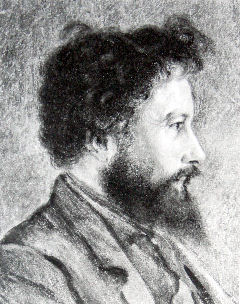ARTS AND CRAFTS MOVEMENT - A SYNOPSIS
The heyday of the arts and Crafts Movement was from the late 1880s to the start of the Great War but its roots go further back to the 1850s and 60s:
- to the influence of men like John Ruskin who wrote about the social and economic conditions of the country and about the effects of mass production on the working man as well as on the Arts;
- the liberating anti-establishment painting philosophy of the Pre-Raphaelites and later to other artists who were disappointed by the Royal Academy’s concept of ‘good art’ and good art education and its lack of interest in the decorative arts;
- to the idealism of the fearless William Morris who put principles into practice by producing handcrafted goods that were both beautiful and useful and selling them in his Oxford St shop, Morris Marshall, Faulkner & Co from 1862 (Morris & Co. from 1875) and whose writings were an inspiration to many making him the respected ‘Father of the Movement’;
- and to path-finding architects like Butterfield, Street, Burges, Bodley, Pearson, Webb Shaw and Nesfield who tugged forcefully to loosen the apron strings of conventional High Victorian style and who took delight in the art of interior decoration of the churches and country houses that they designed. In so doing they gave encouragement to the next generation of architects to create free-style buildings that met their clients needs and were fit for their turn-of-the-century purpose.
The Movement was a call to return to the celebration of the creativity of the individual artist craftsman and at its centre was a belief that art in all its forms would enhance the life of every man. Value should be based not on costliness or showiness but on the skill of designer and craftsman in creating an object of beauty, which must be: fit for purpose; based on an understanding of the materials used; take inspiration from nature and from the past and use decoration to enhance both form and use.
These criteria were based on principles propounded by Ruskin in his book ‘Stones of Venice’ in which he called for a return to the values of medieval Gothic. It was also a call for the return of the decorative arts to their rightful place alongside Fine Art and Architecture.
In the 1880s Guilds, Societies and Associations were formed to promote and sustain these ideas……
More information can be found in the Appendix entitled ‘Synopsis of Arts and Crafts Movement’ in both books.
The Arts and Crafts Movement in the North East of England: A Handbook – 304 pages, 360 colour photographs
The Arts and Crafts Movement in Yorkshire: A Handbook – 424 pages, 535 colour photographs
by Barrie and Wendy Armstrong
John Ruskin

Courtesy of the Frank Sutcliffe Gallery, Whitby
William Morris

Courtesy of the National Portrait Gallery

